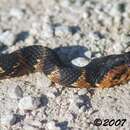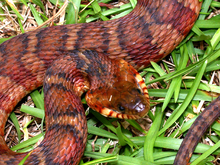pt-BR
nomes no trilho de navegação


Die Südliche Schwimmnatter (Nerodia fasciata), auch Gebänderte Wassernatter oder Gebänderte Schwimmnatter, ist eine semiaquatisch lebende, ungiftige Natternart, die im Südosten Nordamerikas vorkommt. Sie gehört zu den amerikanischen Wassernattern der Gattung Nerodia.
Die Südliche Schwimmnatter kann bis zu 120 cm groß werden, wobei Weibchen mit einer durchschnittlichen Kopf-Rumpf-Länge von 64 cm und einer Schwanzlänge von 16 Zentimetern deutlich größer werden als die Männchen, die jedoch relativ zur durchschnittlichen Kopf-Rumpf-Länge von 54 cm einen längeren Schwanz (18 cm) haben. Mit durchschnittlich 247 Gramm werden die Weibchen auch deutlich schwerer als die Männchen mit einem Gewicht von durchschnittlich 114 Gramm.[2]
Die Südliche Schwimmnatter kann grau, grau-grün oder braun gefärbt sein. Auf dem Rücken hat sie 11 bis 35 große, dunkle Flecken.[1] Einige Exemplare weisen eine so dunkle Farbe auf, dass Zeichnung kaum wahrnehmbar ist. Die Natter besitzt einen flachen Kopf und ist kräftig gebaut.
Die Südliche Schwimmnatter ist rund um Louisiana verbreitet und kommt dort über Arkansas und Mississippi im Norden bis nach Missouri und Illinois vor. Im Westen erreicht ihr Verbreitungsgebiet Oklahoma und zieht sich bis in den Südosten von Texas. Entlang der Südostküste Nordamerikas zieht sich das Verbreitungsgebiet entlang der Küste bis Virginia, wobei die Natter in ganz Florida lebt und dort die häufigste Art der Gattung Nerodia ist.[1][3]
Die Südliche Schwimmnatter benötigt feuchte Habitate wie Seen, Teiche, Flüsse aber auch Entwässerungsgräben, Marschland, Sümpfe und Salzwasserwiesen wie den Everglades.[3] Allerdings benötigt sie Zugang zu Süßwasser, um zu trinken.[4]
Die Südliche Schwimmnatter ist die meiste Zeit des Jahres tagaktiv und nur im Hochsommer bis in den Oktober hinein nachtaktiv, um die Hitze zu meiden. Die Schlange verbringt etwa 60 % ihres Lebens im Wasser und kann, indem sie ihren Puls von 33 Schlägen pro Minute auf knapp 7 absenkt, bis zu 24 Minuten tauchen. Je nach Wetterlage befindet sie sich ab Dezember bis Ende Februar in der Kältestarre.[4]
Kommentkämpfe wurden bei der Südlichen Schwimmnatter nicht beobachtet, die Männchen gehen zur Paarungssaison aktiv auf die Suche nach Weibchen.[2] Je nach Futterangebot und Tiereigenschaften tritt die Geschlechtsreife im zweiten oder dritten Jahr ein.[5] Die Art ist ovovipar.[1] Zwischen Juli und September bringen trächtige Weibchen 7–40 Junge zur Welt, die 18–24 Zentimeter lang sind.[4] Die Natter kann bis zu zehn Jahre alt werden.[5]
Während juvenile Exemplare der Südlichen Schwimmnatter nahezu ausschließlich Fische erbeuten, fressen erwachsene Tiere hauptsächlich Frösche und andere Amphibien. Gründe für den Wechsel der Nahrungsgrundlage kann sein, dass die in den Lebensräumen häufigen Amphibien für juvenile Tiere zu schwer zu verschlingen sind und dies auch zu lange dauern würde. Neben dem dazu nötigen, größeren Energieaufwand, wäre die Schlange auch länger gefährdet, selbst zur Beute zu werden.[6]
Man unterscheidet drei Unterarten:[1]
Die Südliche Schwimmnatter (Nerodia fasciata), auch Gebänderte Wassernatter oder Gebänderte Schwimmnatter, ist eine semiaquatisch lebende, ungiftige Natternart, die im Südosten Nordamerikas vorkommt. Sie gehört zu den amerikanischen Wassernattern der Gattung Nerodia.
The banded water snake or southern water snake (Nerodia fasciata) is a species of mostly aquatic, nonvenomous, colubrid snakes endemic to the Midwest and Southeastern United States.
N. fasciata is natively found from Indiana, south to Louisiana, and east to Florida.
In 1992, its congener Nerodia sipedon (northern or common water snake) and it were found in three sites in California by the US Fish and Wildlife Service (USFWS). In 2009, more than 300 banded water snakes were caught in suburbs of Los Angeles by the Nerodia Working Group of USFWS. Then in May 2016, the species was found in the Colorado River basin near Yuma, Arizona. Further trapping did indeed catch large numbers of them, indicating that a thriving invasive population exists in that area.[6][7][8]
Adults of the banded water snake measure from 61.0 to 107 cm (24.0 to 42.1 in) in total length, with a record size (in the Florida subspecies) of 158.8 cm (62.5 in) in total length.[9] In one study, the average body mass of adult banded water snakes was 464.3 g (16.38 oz).[10]
It is typically gray, greenish-gray, or brown in color, with dark crossbanding. Many specimens are so dark in color that their patterning is barely discernible. The ventrum (belly) is typically an off-white to white. They have flat heads, and are fairly heavy-bodied. Banded water snakes may also be identified by a dark stripe which extends from the eye to the angle of the jaw. If irritated, they release a foul-smelling musk to deter predators. This species also exhibits sexual dimorphism in which the female is generally longer and heavier than the male.[11] The average frequency of skin shedding has been found to be every four weeks.[12]
Their appearance leads them to be frequently mistaken for other snakes with which they share a habitat, including the venomous cottonmouth.
N. fasciata inhabits most freshwater environments such as lakes, marshes, ponds, and streams.[13] Banded water snakes are active both day and night and may be seen basking on logs or branches overhanging the water or foraging in shallow water.[14] They will typically stay within emergent vegetation along the shoreline or in the shallow littoral zone of their habitat. [15]
The species preys mainly on fish and frogs.[16] On occasion, they prey on small turtles, small snakes, birds, earthworms, and crawfish.[17] Juveniles mainly consume fish and shift towards eating frogs as adults. This shift may be caused by large frogs being mechanically too difficult for juveniles to consume (which may suggest juveniles may be unable to open their jaws wide enough for adult frogs), because large frogs are energetically too costly for juveniles to catch, or because juveniles are at risk if swallowing prey requires a long time.[18]
Using its vomeronasal organ, also called Jacobson's organ, the snake can detect parvalbumins in the cutaneous mucus of its prey.[5]
The species is viviparous, giving birth to live young.[19] The brood size varies from 15 to 20 young born in late July or August.[14] Newborns are 200–240 mm (about 8.0–9.5 in) in total length.[20] The banded water snake is able to hybridize with the common watersnake, although this is not frequent. Physical characteristics are insufficient to distinguish such hybrids, and DNA analysis is required. [21]
When threatened, banded water snakes flatten their bodies to appear larger and emit a foul musk from their anal glands, and bite repeatedly. They will slash sideways when biting to tear the flesh of the attacker. [22]
The three recognized subspecies of N. fasciata, including the nominotypical subspecies, are:[19]
Some sources consider N. clarkii compressicauda and N. clarkii taeniata to be subspecies of N. fasciata.[24] Also, some sources have considered Nerodia fasciata to be a subspecies of Nerodia sipedon.[3][20][25]
 An unusual reddish specimen of banded water snake.
An unusual reddish specimen of banded water snake. The banded water snake or southern water snake (Nerodia fasciata) is a species of mostly aquatic, nonvenomous, colubrid snakes endemic to the Midwest and Southeastern United States.
Nerodia fasciata Nerodia generoko animalia da. Narrastien barruko Natricidae familian sailkatuta dago.
Nerodia fasciata Nerodia generoko animalia da. Narrastien barruko Natricidae familian sailkatuta dago.
Nerodia fasciata est une espèce de serpents de la famille des Natricidae[1].
Cette espèce est endémique des États-Unis. Elle se rencontre dans l'est du Texas, dans le sud-est de l'Oklahoma, en Louisiane, dans l'Arkansas, dans l'ouest du Mississippi, dans le sud de l'Alabama, en Géorgie, en Caroline du Sud, dans l'Illinois, en Floride, en Caroline du Nord et dans le sud-est du Missouri[1].
Ce serpent vivipare atteint 60 à 70 cm et est gris, vert pâle ou brun, avec des bandes sombres (chez les individus sombres les bandes sont presque invisibles). La tête est plate, avec un corps assez épais.
Selon Reptarium Reptile Database (10 septembre 2013)[2] :
Nerodia fasciata est une espèce de serpents de la famille des Natricidae.
A cobra-d'água listrada ou cobra-d'água do sul (Nerodia fasciata) é uma espécie de cobra colubrida, principalmente aquática, endêmica do meio-oeste e sudeste dos Estados Unidos.
É encontrada nativamente de Indiana, ao sul da Louisiana e ao leste da Flórida.
Em 1992, seu congênere Nerodia sipedon (cobra-d'água do norte ou comum) foi encontrado em três locais na Califórnia pelo US Fish and Wildlife Service (USFWS). Em 2009, mais de 300 cobras-d'água foram capturadas nos subúrbios de Los Angeles pelo Grupo de Trabalho Nerodia do USFWS. Então, em maio de 2016, a espécie foi encontrada na bacia do rio Colorado perto de Yuma, Arizona . Outras armadilhas realmente capturaram um grande número deles, indicando que existe uma próspera população invasora naquela área.[4][5][6]
Os adultos medem de 61 a 107 cm de comprimento total, com um tamanho recorde (nas subespécies da Flórida) de 158,8 cm.[7] Em um estudo, a massa corporal média de cobras-d'água listradas adultas foi de 464,3 g .[8]
É tipicamente cinza, cinza-esverdeado ou marrom, com faixas cruzadas escuras. Muitos espécimes são de cor tão escura que seu padrão é quase imperceptível. Eles têm cabeças achatadas e são bastante corpulentos. Se irritadas, elas liberam um almíscar fedorento para afastar os predadores.
Sua aparência as leva a serem frequentemente confundidos com outras cobras com as quais compartilham um habitat, incluindo as menos comuns como a mocassim-d'água
A cobra-d"água listrada habita a maioria dos ambientes de água doce, como lagos, pântanos, lagoas e riachos.[9]
Alimenta-se principalmente de peixes e sapos.[10] Usando seu órgão vomeronasal, também chamado de órgão de Jacobson, a cobra-d"água listrada pode detectar parvalbuminas no muco cutâneo de sua presa.[11]
A espécie é ovovípara, dando à luz filhotes vivos. O tamanho da ninhada varia de 9 a 50. Os recém-nascidos medem de 200 a 240mm de comprimento total.[12]
As três subespécies reconhecidas de cobra-d"água listrada, incluindo as subespécies nominotípicas, são: [13]
Algumas fontes consideram Nerodia clarkii compressicauda e Nerodia clarkii taeniata como subespécies de Nerodia fasciata .[14] Além disso, algumas fontes consideram Nerodia fasciata uma subespécie de Nerodia sipedon .[12][15]
A cobra-d'água listrada ou cobra-d'água do sul (Nerodia fasciata) é uma espécie de cobra colubrida, principalmente aquática, endêmica do meio-oeste e sudeste dos Estados Unidos.
Nerodia fasciata là một loài rắn trong họ Rắn nước. Loài này được Linnaeus mô tả khoa học đầu tiên năm 1766.[5]
Nerodia fasciata là một loài rắn trong họ Rắn nước. Loài này được Linnaeus mô tả khoa học đầu tiên năm 1766.

 分類 界 : 動物界 Animalia 門 : 脊索動物門 Chordata 亜門 : 脊椎動物亜門 Vertebrata 綱 : 爬虫綱 Reptilia 目 : 有鱗目 Squamata 亜目 : ヘビ亜目 Serpentes 科 : ユウダ科 Natricidae 属 : ミズベヘビ属 Nerodia 種 : ナンブミズベヘビ
分類 界 : 動物界 Animalia 門 : 脊索動物門 Chordata 亜門 : 脊椎動物亜門 Vertebrata 綱 : 爬虫綱 Reptilia 目 : 有鱗目 Squamata 亜目 : ヘビ亜目 Serpentes 科 : ユウダ科 Natricidae 属 : ミズベヘビ属 Nerodia 種 : ナンブミズベヘビナンブミズベヘビ(南部水辺蛇、Nerodia fasciata)は、ユウダ科ミズベヘビ属に分類されるヘビ。
アメリカ合衆国南東部
全長60-100cm。体色は暗色で褐色の横帯が入るが、個体による変異が大きい。
河川、湖、池沼等の水辺や湿地等に生息する。夜行性だが、木の枝等の上で日光浴を行うことも好む。性質は荒く、危険を感じると噴気音を出して威嚇したり噛みつくこともある。
繁殖形態は卵胎生で、1回に2-57頭の幼体を産む。
開発による生息地の破壊や、毒蛇と間違われ駆除される等の理由で生息数は減少している。
ペットとして飼育されることもあり、日本にも輸入されている。性質が荒く、触れようとすると暴れる。
|date= (help)CS1 maint: Uses authors parameter
줄무늬물뱀(영어: banded water snake)는 뱀과 물뱀속에 딸린 뱀 종이다. 수생성이며, 독이 없다. 미국 중남부에만 서식하는 고유종이다.